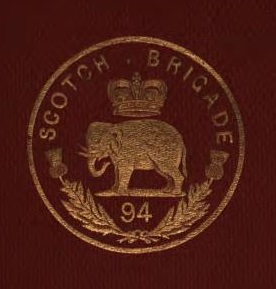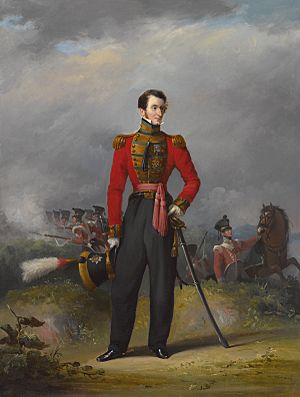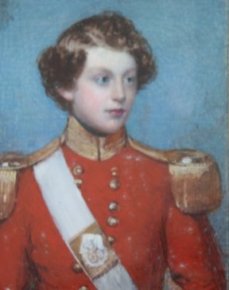94th Regiment of Foot facts for kids
Quick facts for kids 94th Regiment of Foot |
|
|---|---|

Badge of the 94th Regiment of Foot
|
|
| Active | 1794–1818 1823–1881 |
| Country | |
| Branch | |
| Type | Line Infantry |
| Role | Infantry |
| Size | One battalion |
| Garrison/HQ | Gough Barracks, Armagh |
| Engagements | Fourth Anglo-Mysore War Second Anglo-Maratha War Napoleonic Wars Mappila riots Anglo-Zulu War Basuto Gun War First Boer War |
The 94th Regiment of Foot was a special group of soldiers from the British Army. They were a type of soldier called 'line infantry'. They started as the 'Scotch Brigade' in October 1794.
Later, in December 1802, they were renamed the 94th Regiment of Foot. This group was active for some years, then stopped in December 1818. But they came back in December 1823! They served until 1881. At that time, they joined with another group, the 88th Regiment of Foot. Together, they formed a new regiment called the Connaught Rangers.
Contents
History of the 94th Regiment
How the Regiment Started
The 94th Regiment began on October 9, 1794. General Francis Dundas created it. It was first called the Scotch Brigade. Many of its first officers had served in a similar group before.
In November 1795, the regiment traveled to Gibraltar. Then, in 1796, they moved to South Africa. By late 1798, they were in India. They arrived in Madras in January 1799.
The soldiers fought in the Fourth Anglo-Mysore War. They took part in the Battle of Mallavelly in March 1799. They also helped in the siege of Seringapatam in April 1799.
In December 1802, the group was officially renamed the 94th Regiment of Foot. They also fought in the Second Anglo-Maratha War. This included the Battle of Argaon in November 1803. They also helped Capture of Gawilghur in December 1803.
At Gawilghur, Captain Campbell led his soldiers. They climbed ladders over the fort walls. These walls were thought to be impossible to get past. His brave actions allowed the rest of the British army to enter through the main gate. The regiment left India in October 1807 to return home.
Fighting in the Napoleonic Wars
In April 1809, the regiment sailed to Jersey. Then, in August 1809, they went to Portugal. They were there to fight in the Peninsular War. They landed in Lisbon in February 1810. A few days later, they helped defend Fort Matagorda during the siege of Cádiz.
Captain Archibald Maclaine led a small group of 155 men. They bravely held off a much larger force of 8,000 soldiers. For his courage, Captain Maclaine was made a knight and promoted to Major.
The regiment continued to fight in many important battles. These included the Battle of Sabugal in April 1811. They also fought at the Battle of Fuentes de Oñoro in May 1811. They helped in the siege of Ciudad Rodrigo in January 1812.
After that, they fought in the siege of Badajoz in March 1812. They were also at the Battle of Salamanca in July 1812. They helped with the siege of Burgos in September 1812. A big victory was the Battle of Vitoria in June 1813.
The soldiers then chased the French army into France. They fought at the Battle of Nivelle in November 1813. Other battles included the Battle of the Nive in December 1813. They also fought at the Battle of Orthez in February 1814. Their last major battle was the Battle of Toulouse in April 1814.
In May 1814, they sailed to Cork, Ireland. The regiment was officially stopped in Dublin in December 1818.
The Victorian Era and Later Years

The regiment was started again in Glasgow in December 1823. This happened because of a threat from France in Spain. The new regiment was recognized as the same as the old one. This meant they kept all their past battle honors. Two officers from the original 94th Regiment joined the reformed group.
In April 1824, the regiment moved to Gibraltar. They received their new regimental colours (special flags) in April 1825. Then, they went to Malta in March 1832. They returned to Ireland in November 1834.
The regiment was sent to Ceylon in October 1838. Then, they moved to Cannanore in April 1839. They served in the Madras Presidency in India for 15 years. During this time, they helped stop the Mappila riots in the summer of 1849. The regiment sailed back to England in March 1854.
Some soldiers volunteered to fight in the Crimean War in November 1854. The main part of the regiment went to Gibraltar in September 1855. The largest group of soldiers traveled to Karachi in November 1857. Then, they moved to Peshawar in the North-West Frontier region in October 1858. The regiment returned home again in January 1868.
In spring 1879, the regiment went to South Africa. They fought in the Battle of Ulundi in July 1879 during the Anglo-Zulu War. The regiment marched into the Transvaal. They took part in a successful attack on Sekukuni's stronghold on November 28, 1879. This was during the Basuto Gun War. Two Victoria Crosses were given to soldiers from the regiment for their bravery in this fight.
The regiment stayed in South Africa. Its eight companies were spread out in the Transvaal. They were in places like Pretoria, Lydenburg, and Wakkerstroom. In December 1880, two companies were attacked at the Battle of Bronkhorstspruit. This was the start of the First Boer War. Many soldiers were killed or wounded, and the rest were captured. The other six companies were surrounded by the Boers during the war.
In 1881, the 94th Regiment of Foot joined with the 88th Regiment of Foot. Together, they became the Connaught Rangers. This was part of a big change in the British Army.
Battle Honours
Battle honours are special awards given to military units. They show which important battles the regiment fought in. Here are some of the honours won by the 94th Regiment:
- Fourth Anglo-Mysore War : Seringapatam
- Peninsular War: Peninsular, Ciudad Rodrigo, Badajos, Salamanca, Vitorria, Nivelle, Orthes, Toulouse
Victoria Crosses
The Victoria Cross is the highest award for bravery in the British military. Two soldiers from the 94th Regiment earned this award:
- Private Francis Fitzpatrick - for his actions at King Sekhukhune’s Stronghold, November 28, 1879
- Private Thomas Flawn - for his actions at King Sekhukhune’s Stronghold, November 28, 1879
Colonels of the Regiment
A Colonel of the Regiment is a senior officer who leads and represents the regiment. Here are some of the colonels:
- Scotch Brigade
- 1794–1809: Gen. Francis Dundas
- 94th Regiment of Foot
- 1809–1815: Gen. Sir Rowland Hill, 1st Viscount Hill, GCB, GCH, KC
- 1815–1818: ?
- Regiment stopped in 1818
- 94th Regiment of Foot (Reformed)
- Regiment started again in 1823
- 1823–1829: Gen. Sir Thomas Bradford, GCB, GCH
- 1829–1831: Lt-Gen. Sir John Keane, 1st Baron Keane, GCB, GCH
- 1831–1834: Maj-Gen. Sir James Campbell, KCB, KCH
- 1834–1838: F.M. Sir John Colborne, 1st Baron Seaton, GCB, GCMG, GCH
- 1838–1847: Gen. Sir Thomas McMahon, Bt., GCB
- 1847–1853: Lt-Gen. Sir William Warre, CB
- 1853–1854: Maj-Gen. William Staveley, CB
- 1854: Lt-Gen. Henry Thomas, CB
- 1854–1855: Lt-Gen. Hon. Henry Edward Butler
- 1855–1866: Gen. George Powell Higginson
- 1866–1872: Gen. Sir Edward Walter Forestier-Walker, KCB
- 1872–1879: Gen. Henry Jervis
- 1879: Gen. Richard William Penn Curzon-Howe, 3rd Earl Howe, GCVO, CB
- 1879–1881: Gen. Sir John Thornton Grant, KCB



